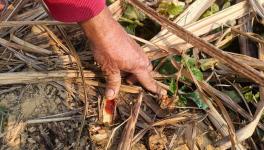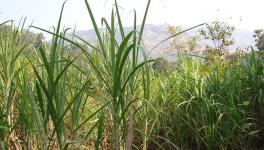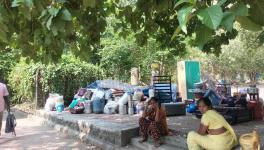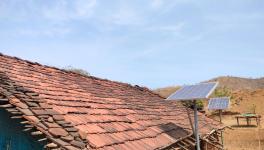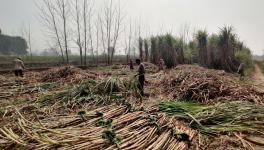Lives of Peasants in India #13
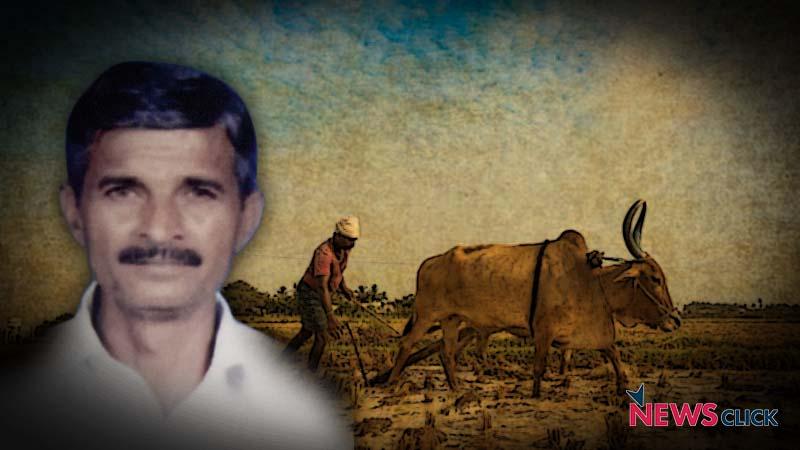
Newsclick Image by Sumit
The year 2017 saw an outpouring of farmers’ protests sweeping the country. To understand why they happened, NewsClick presents a series of profiles of farmers from different parts of India, based on interviews done by students from Delhi, guided by the Society for Social & Economic Research (SSER). See Introduction to series.
Kolhapur district in Southern Maharashtra is a prosperous rural region of the state. Sugarcane is the most important crop grown here. Maharashtra accounts for about 20 per cent of national production of sugarcane. Of this, about 40 per cent comes from the Kolhapur sub-division. The region has a large number of sugar mills. Although most of these sugar mills are cooperatives of farmers, they are controlled by a few politically powerful and economically wealthy sugar barons. Historically, sugar barons from this region, with their large irrigated landholdings and control over sugar mills, have wielded considerable political power in Maharashtra.
While southern Maharashtra is known for its prosperity, it is also a region with high economic inequalities. Rich capitalist farmers and sugar barons have benefited greatly from the growth of the sugar economy since the 1970s. On the other hand, a vast majority of poor and middle peasants struggle to negotiate a complex production and contracting system. Delays in harvesting and lifting the contracted cane and delays in payment by sugar mills have been persistent problems for sugarcane farmers in Maharashtra. More recently, demonetisation dealt a particularly severe blow to farmers growing commercial crops like sugarcane. This account of farming by Pilasaheb Sitaram Deshmukh's household shows that, even in a prosperous region such as Kolhapur, an average peasant struggled to make his ends meet.
Pilasaheb Sitaram Deshmukh has a large joint family comprising a total of 8 members. The household has 7.5 acres of land located near the confluence of the Panchganga and Krishna rivers. The land is irrigated by a cooperative minor lift irrigation project called Shri Dutt Pani Parvota. The 40-year old irrigation system pumps water from the Panchganga river and irrigates about 40 acres of land belonging to 15 households.
About 2.5 acres of Deshmukh's land is low lying and is flooded by the river for half of the year. For the rest of the year, fodder crops are grown on this land for the three buffaloes that his household owns.
Deshmukh's household has two other plots of land, one of 2 acres and another of 3 acres, both of which are used for growing sugarcane. On both the plots, sugarcane cultivation follows a crop rotation cycle of three years comprising a planted crop of sugarcane (which is intercropped with groundnut or soybean) followed by a ratoon crop of sugarcane. Although both the plots have a three-year cropping cycle, sugarcane is planted on these plots in different years. Planting sugarcane in different years staggers the investment requirements and reduces the amount of labour that needs to be mobilised in any year. The planted crops and the ratoon crops mature in different months. With staggered planting, a part of the sugarcane is harvested in November-December and the rest in January-February. This ensures smoother delivery of sugarcane to mills. In Maharashtra, sugarcane is harvested as per a schedule drawn by each sugar mill for the planted crop and for the ratoon crop. Harvesting, for which peasants are charged by the mill, is done by labour gangs contracted by each sugar mill.
Deshmukh's household started a fresh cropping cycle on the 3-acre plot in 2016. It started with thoroughly tilling the soil, application of farm yard manure and fertilisers, and creation of ridges and furrows on the plot. In June 2016, groundnut was sown on the ridges. A month and a half later, in August 2016, sugarcane setts (sugarcane cuttings) were planted in the furrows. Groundnut was harvested in November 2016, while sugarcane plants were still very small. The focus then shifted to sugarcane. As the canes grew, earth from the ridges was hoed and pressed around the sugarcane plants to support them. During this period of plant growth, the field was repeatedly irrigated, fertiliser and plant protection chemicals were applied, and weeds were removed. Eventually, as the canes grew to their full length, they were tied together in bunches to further prevent lodging. The canes were ready for harvest by about October, 2017. However, until the time of writing this account, at the end of December 2017, his planted crop of sugarcane had not been harvested. The sugar mill started its operations a month later than usual and Deshmukh's turn for harvesting had not yet come. Delay in delivery of sugarcane meant that about Rs. 1.6 lakhs of paid out expenditure he had incurred on the crop remained locked. He was unable to repay the Rs. 2.5 lakh crop loan he had taken. Moreover, he had to further invest in irrigation and maintenance of the crop until his turn came to deliver the cane.
A similar three-year cycle was started in 2014 on the 2-acre plot. After harvesting the planted crop around December 2015, a ratoon crop of sugarcane was allowed to grow. Since the cost of production of the ratoon crop is lower than the planted crop – Deshmukh incurred a paid out expenditure of about Rs. 80,000 for 2-acres of the ratoon crop – farmers get a good return from the crop. The ratoon crop of 80 tonnes sugarcane was harvested in January 2017 and sold for Rs. 2.4 lakhs. However, because of demonetisation, he was unable to withdraw any money for two months after the sale. Although the input dealer he usually bought fertilisers from provided inputs on credit in the past, he stopped doing so in the months following demonetisation because he was not receiving repayments of earlier advances from farmers. Despite having Rs. 2.4 lakhs proceeds from the sale of his ratoon crop in his bank account, Deshmukh had to borrow Rs. 20,000 from his relatives to buy fertilisers and pay wages to workers.
After harvesting the ratoon crop and before the new cropping cycle would start, the land was left fallow for four months. During this period, they applied manure, ploughed the land and made it ready for cultivation. This time, Deshmukh's household chose to plant soybean on the ridges as the market prices of soybean had been very high (Rs. 3300 per quintal) in the previous year (2016). Soybean was sown on the ridges in May 2017, followed by planting of sugarcane setts in July in the furrows. In July 2017, they harvested 11 quintals of soybean. However, this year the prices of soybean fell to about Rs. 2500 per quintal. As a result, until December 2017, five months after the crop had been harvested, the household had been unable to sell their soybean.
In other words, even a farmer like Pilasaheb Sitaram Deshmukh, with 7.5 acres of irrigated land in prosperous Kolhapur district, faced serious problems in selling each of the three crops he harvested in 2017. While the ratoon sugarcane crop harvested in January fetched him a good return, he was unable to use any of the money for two months because of demonetisation. The soybean crop he harvested in July could not be sold because of a crash of prices. The planted crop of sugarcane that matured in October was not harvested until the end of December because of delayed operations of the sugar mill.
Vikas Rawal is Professor at the Jawaharlal Nehru University, New Delhi.
Part 1 of the series can be read here.
Part 2 of the series can be read here.
Part 3 of the series can be read here
Part 4 of the series can be read here
Part 5 of the series can be read here
Part 6 of the series can be read here
Part 7 of the series can be read here
Part 8 of the series can be read here
Part 9 of the series can be read here
Part 10 of the series can be read here
Part 11 of the series can be read here
Part 12 of the series can be read here
Disclaimer: The views expressed here are the author's personal views, and do not necessarily represent the views of Newsclick.
Get the latest reports & analysis with people's perspective on Protests, movements & deep analytical videos, discussions of the current affairs in your Telegram app. Subscribe to NewsClick's Telegram channel & get Real-Time updates on stories, as they get published on our website.









